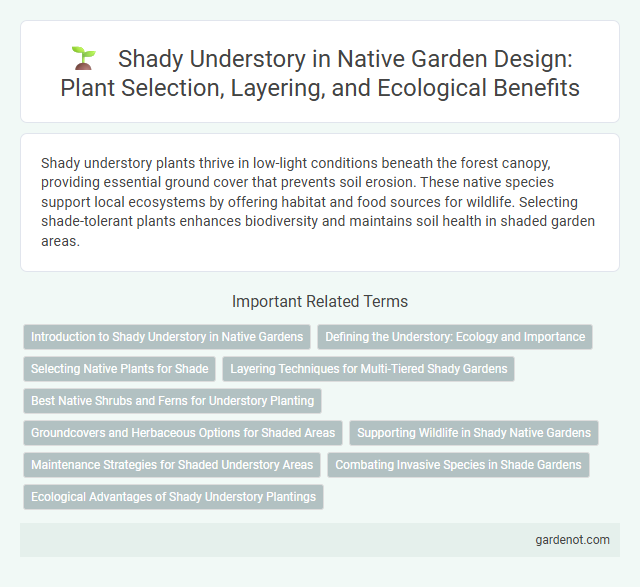Shady understory plants thrive in low-light conditions beneath the forest canopy, providing essential ground cover that prevents soil erosion. These native species support local ecosystems by offering habitat and food sources for wildlife. Selecting shade-tolerant plants enhances biodiversity and maintains soil health in shaded garden areas.
Introduction to Shady Understory in Native Gardens
Shady understory plants thrive in lower light conditions beneath tree canopies, creating diverse habitats within native gardens. These plants, such as ferns, hostas, and woodland wildflowers, contribute to soil health, moisture retention, and provide shelter for local wildlife. Incorporating a variety of native shady understory species enhances ecological balance and supports pollinators in shaded garden areas.
Defining the Understory: Ecology and Importance
The shady understory plays a critical role in forest ecology by providing habitat and nutritional resources for diverse plant and animal species. Understory vegetation, typically comprising shade-tolerant shrubs, ferns, and small trees, contributes to soil health through organic matter decomposition and moisture retention. Understanding the complexity of understory layers enhances native planting strategies aimed at promoting biodiversity and ecosystem stability.
Selecting Native Plants for Shade
Selecting native plants for shady understory environments enhances biodiversity and supports local ecosystems by providing habitat and food sources for native wildlife. Species such as ferns, wild ginger, and Solomon's seal thrive in low-light conditions while improving soil health and moisture retention. These shade-tolerant natives require minimal maintenance and adapt well to filtered sunlight, making them ideal for creating sustainable, shaded garden layers.
Layering Techniques for Multi-Tiered Shady Gardens
Layering techniques in shady understory gardens create multi-tiered plant structures by combining tall canopy trees, mid-sized shrubs, and low-growing groundcovers to maximize space and light capture. Selecting native shade-tolerant species like Eastern Redbud (Cercis canadensis), Spicebush (Lindera benzoin), and Wild Ginger (Asarum canadense) enhances biodiversity and supports local ecosystems. Utilizing diverse plant heights and textures promotes soil health, reduces erosion, and provides habitat for pollinators and wildlife in shaded environments.
Best Native Shrubs and Ferns for Understory Planting
Best native shrubs for shady understory planting include spicebush (Lindera benzoin), inkberry holly (Ilex glabra), and American witch-hazel (Hamamelis virginiana), which thrive with limited sunlight and provide essential habitat for local wildlife. Native ferns such as Christmas fern (Polystichum acrostichoides), maidenhair fern (Adiantum pedatum), and northern lady fern (Athyrium filix-femina) excel in moist, shaded environments, enhancing biodiversity and soil health. These plants contribute to a resilient understory layer by stabilizing soil, offering food sources, and supporting pollinators and birds.
Groundcovers and Herbaceous Options for Shaded Areas
Shady understory groundcovers such as native ferns, wild ginger (Asarum canadense), and foamflower (Tiarella cordifolia) thrive in low-light environments, effectively reducing soil erosion and suppressing weeds. Herbaceous options including blue cohosh (Caulophyllum thalictroides) and solomon's seal (Polygonatum spp.) provide seasonal interest with unique foliage and delicate flowers well-suited for forest floor conditions. These native plants support local biodiversity by offering habitat and food sources for pollinators and wildlife in shaded garden areas.
Supporting Wildlife in Shady Native Gardens
Shady understory native plants create essential habitats that support diverse wildlife, including pollinators, birds, and small mammals. Species such as wild ginger, bloodroot, and foamflower provide food, shelter, and breeding grounds, enhancing biodiversity in low-light environments. Incorporating these plants in shady gardens fosters ecological balance and sustains native ecosystems.
Maintenance Strategies for Shaded Understory Areas
Maintaining shaded understory areas with native plants requires careful management of soil moisture and nutrient levels to support shade-tolerant species like ferns, wild ginger, and native azaleas. Regular removal of invasive plants and leaf litter helps prevent competition and promotes healthy growth while minimizing disease risk in low-light conditions. Mulching with organic materials enhances soil structure and retains moisture, creating an optimal environment for native understory vegetation.
Combating Invasive Species in Shade Gardens
Shady understory planting with native species plays a crucial role in combating invasive species in shade gardens by establishing dense, competitive vegetation that suppresses invasive growth. Native shade-tolerant plants like ferns, trilliums, and Solomon's seal create multi-layered canopies, reducing light availability essential for invasive species such as Japanese stiltgrass and garlic mustard. Maintaining biodiversity through native understory plants enhances soil health and ecosystem resilience, effectively limiting invasive species encroachment in shaded environments.
Ecological Advantages of Shady Understory Plantings
Shady understory plantings enhance biodiversity by providing critical habitat and food sources for native wildlife, including pollinators and birds. These plants improve soil health through organic matter deposition and moisture retention, reducing erosion and promoting nutrient cycling. Their shade moderates microclimates, supporting ecosystem resilience against temperature extremes and drought.
Shady understory Infographic

 gardenot.com
gardenot.com